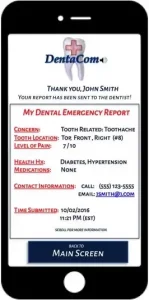INDIANAPOLIS — Have a dental emergency? Your smartphone may be able to help you avoid an unnecessary trip to the hospital.
A team mentored by Thankam Thyvalikakath, DMD, PhD, now of the Indiana University School of Dentistry and of the Regenstrief Institute, has developed and tested a novel mobile application enabling smartphones to capture and transmit images from inside the mouth, along with details on the dental emergency, to provide the information dentists need to make a decision on what — and how urgently — care is needed.
Seeking to improve emergency dental care, the researchers developed DentaCom, a cell phone application that enables dentists to make decisions when they cannot see the patient. “A Prototype Mobile Application for Triaging Dental Emergencies” is published in the October 2016 issue of The Journal of the American Dental Association and is featured on the issue’s cover. The authors were at the University of Pittsburgh at the time of the study.

The new app guides individuals with real or suspected dental emergencies through a series of questions designed to capture clinically meaningful data via familiar smartphone functions. In the study, all participants were able to complete a guided report on their dental emergency and take photos of the problem region within four minutes. All clinical information was successfully entered by prospective patients via DentaCom.
“There are many challenges here that our app can help with,” said Thyvalikakath, the paper’s senior author. “It is a challenge for the patient to get the dental emergency appropriately managed, and not just treated by painkillers in a busy hospital ER by a clinician who is not a dental specialist, It is also a challenge for the dentist to get details of the problem.”
Corey Stein, MS, first author of the study and now a dental student at Western University of Health Sciences in California, initially conceived the idea of an app when he experienced a dental emergency. He received the American Dental Association’s 2016 Robert H. Ahlstrom New Investigator Award for his work on DentaCom.
Dental emergencies frequently occur when dental offices are closed. Patients often turn to hospital emergency departments or urgent care centers. But most patients who go to these facilities are simply treated for their pain and referred to their dentist for proper care during office hours. Valuable time may be lost before actual treatment is received, and the patient is billed for the emergency or urgent care visit in addition to whatever dental fees will be incurred.
In contrast to a physician’s office, a dentist’s office is hands-on and procedure based, and it can be difficult to add an emergent patient to the schedule. The DentaCom app provides the detailed guidance that the dentist needs to determine the urgency of, and appropriately treat, the problem.
“We developed this app as a communication tool linking patients and dentists during emergency situations,” said Thyvalikakath, associate professor and the director of Dental Informatics Core in the IU School of Dentistry. “But I see even more potential in nonemergency situations when individuals, particularly those who lack dental insurance, need guidance — do I need to see a dentist or not? It can also be useful in enhancing access to routine dental care.”
In addition to Thyvalikakath and Stein, authors of the study are Xiang Xiao, BS; Steven Levine, DMD; Titus K.L. Schleyer, DMD, PhD and Harry Hochheiser, PhD.
Schleyer is now a research scientist with the Center for Biomedical Informatics at the Regenstrief Institute and is the Clem McDonald Professor of Biomedical Informatics at Indiana University School of Medicine. Xiao, Levine and Hochheiser remain at Pittsburgh.
The study was funded in part by grants from the National Institutes of Health, the Lilly Endowment, the Indiana Physician Scientist Initiative and the National Library of Medicine.
JADA is published by Elsevier.
DOI 10.1016/j.adaj.2016.03.021
Media contact:
Cindy Fox Aisen
Regenstrief Institute
caisen@iupui.edu









